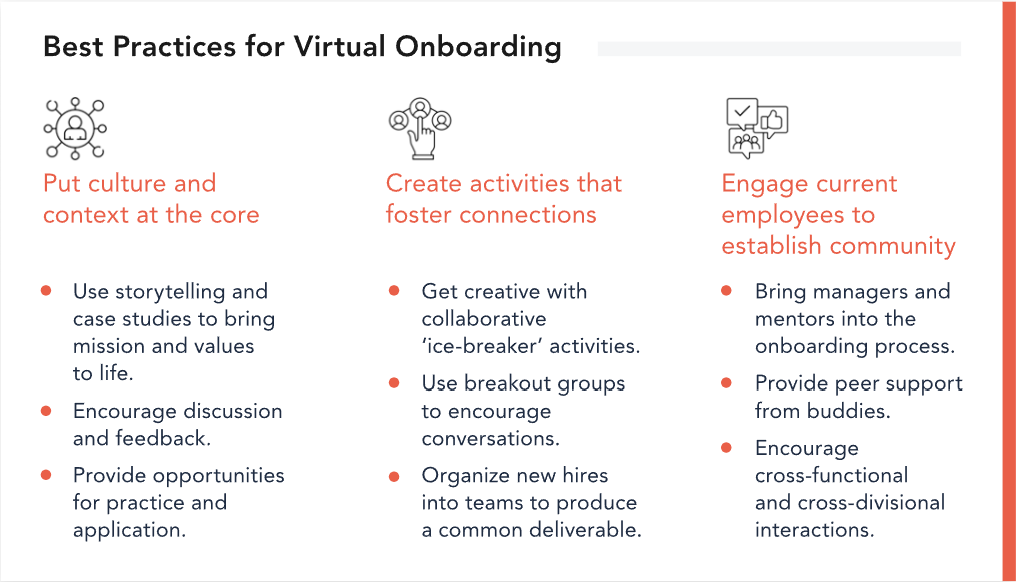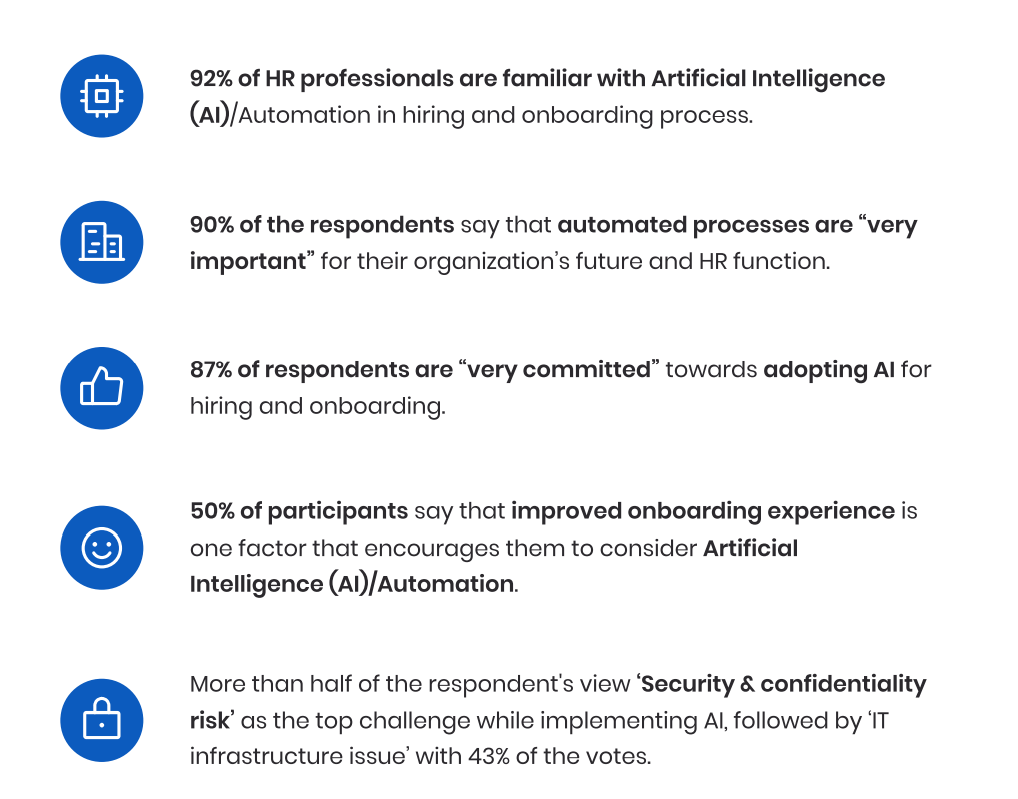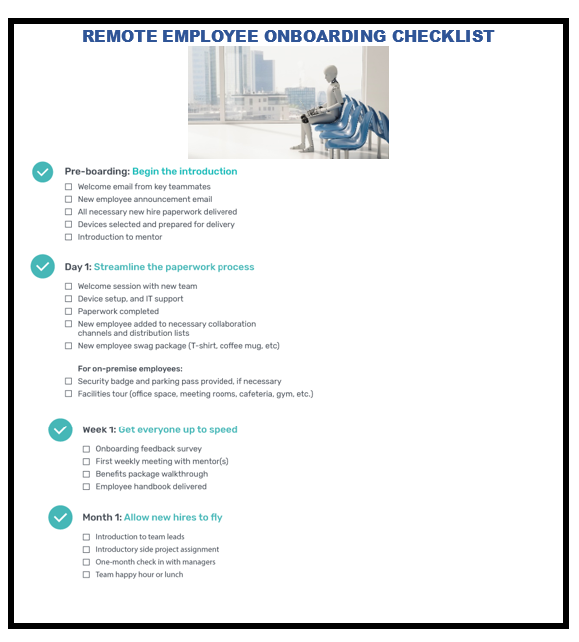Global working culture has undergone a massive transformation over the last few years. How and where people work has become a flexible arrangement where employees may work in an office, in a remote work environment, or in a hybrid combination of the two.
Regardless of a team member's location, it has become an integral part of every company culture to provide new employees, remote workers and in-house team members with equal access to professional development opportunities as well as all the company resources they need.
In this guide we'll discuss best practices for successfully onboarding remote employees so that they can fit seamlessly within company values and the way an organization operates, while creating a mutually beneficial work life balance in a remote environment:
-
We'll cover in detail the steps that every company should take when onboarding remote employees and new hires.
-
We'll reveal why a structured onboarding program will become a key factor in achieving a company's mission, and how important it is to make new remote team members feel connected to a company, even if they are situated in multiple worldwide locations.
-
We'll look at the challenges and opportunities of onboarding remote employees in hybrid and remote work.
-
We'll provide a remote employee onboarding checklist that aims to match the needs of employers with new remote employees, while creating a workplace culture that is mutually beneficial to everyone in a virtual environment.
The importance of the onboarding process
Many organizations struggle to achieve workplace readiness for new hires and teams. In order to prepare them to meet personal and organizational goals that are aligned, they need a well constructed remote onboarding plan. This means that a company's existing onboarding process may need some careful reconsideration, or even complete re-evaluation.
A carefully executed remote employee onboarding process helps speed time to productivity, reduces the rate of employee turnover and creates a positive employee experience.
Conversely, a negative onboarding experience promotes disengagement in the workplace and leads to an increase in staff turnover and additional hiring expenses. This has a domino effect impacting every other team member, seriously affecting your company's culture and ultimately, your total revenue.
Understanding company culture
When onboarding remote employees, many hiring managers within organizations place a high priority on nurturing an understanding of company culture. This applies to new remote workers, as well other team members.
Usually, new remote employees spend the first week of their onboarding process getting to know the company’s vision, mission, values, and culture. This helps new hires become familiar with the organizational structure and specifics of their role. This is important because it's the first impression your new employee will have of your company.

Image source: Brandon Hall Employee Engagement study
Directly linked to company culture is the growing need for diversity within the workplace to create a sense of meaningfulness, belonging and connection for new team members.
Trust is one of the most important core values for fostering remote employee engagement, and this is not achieved by running through a pre-conceived paperwork process as quickly as possible. It's the human and personal aspects of new remote employee engagement that make for successful virtual onboarding.

Best practices for remote onboarding
As mentioned, the right onboarding process can have a dramatic impact on the new employee experience. Here are the top 6 remote employee onboarding best practices for any organization.
-
Start communicating with your new hire well in advance
The best way to ensure a smooth onboarding process for your new team member is to prepare well before their start date - ideally about 1 - 2 weeks before. This can help ease any anxiety or apprehension they might be feeling.
-
If there is an employee handbook, you should ensure that new hires have a copy.
-
Set them up in the right systems, whether it's video conferencing software, company intranet, company devices or other necessary equipment. Also, ask the new employee about their equipment preferences. Giving them a choice will show you want them to feel comfortable in their new working environment.
-
Notify all applicable personnel, such as security and IT, to make sure they don’t encounter any challenges when they arrive.
-
Investigate the value of buddy programs. The onboarding buddy concept can involve a mentor, coach or peer who can answer questions or help your new hire with orientation.
-
Make a new employee announcement
It's important to let existing employees and management know that a new team member has arrived. This fosters relationship building between new hire and co-workers. Share the employee’s name, their role within the organization, key responsibilities and their academic and professional background.
-
Prepare a referenced list of new hire resources
To avoid new hires feeling overwhelmed when trying to locate other employees and information within the company, prepare a welcome kit. This should include:
-
Information on company hierarchy, departments, processes and people.
-
Company history, values and objectives
-
Policies and procedures
-
Educate managers on onboarding expectations
It's a manager's responsibility to provide a seamless onboarding process, whether it's onboarding remote employees or in-office staff. It's crucial to inform managers about proper expectations on training time so that everyone is on the same page about readiness to take on all new responsibilities.
-
Ask new hires for feedback
It's important to get feedback and input from each new hire throughout the onboarding process, whether they are working in a remote environment, or in the office. Their thoughts, experiences and ideas can provide valuable insight into whether your onboarding program is effective or whether there are any areas that can be improved upon.
It’s important to ask for feedback both during the initial onboarding as well as a few weeks and months into the new hire’s employment. Because they’re often inundated with information during the first days, it can take time for them to recognize whether anything is missing.
-
Establish realistic expectations and responsibilities
When working in the remote world, obviously the amount of face-to-face contact between in-office and remote teams will be limited. It's important to constantly monitor the issues that new hires or existing teams may face, like burnout and chronic stress.
Remote working is notorious for dissolving boundaries between home and office, and this can make it difficult for your entire team to fully switch off after work.
Helping remote team members to develop routines, realistic schedules and clear expectations that work for both employer and employee is important. When they know what’s expected, they’ll be more inclined to give themselves room to recharge.
Bring new employees back into the office for coffee meetings, for example. For the first few weeks at least, encourage an occasional face-to-fact meeting, rather than a video call
In the weeks after onboarding, check in with new employees frequently and ask how they’re feeling about their role, and their work-life balance.

Image source: NovoEd
Common remote worker onboarding challenges
As we've already covered in best onboarding practices, there are quite a few practicalities to consider when preparing to take on new employees remotely.
As well as providing the necessary permissions and security clearances, getting systems ready, mapping new endpoints to the network servers there are challenges for many employees associated with remote onboarding:
Becoming familiar with new tools, processes and environments
Working remotely is completely reliant on seamless communication between your new hires, existing teams, and clients and customers. Training and support should be readily available, and ongoing for new team members.
Issues with IT configuration and permissions
The first step in remote onboarding is to make sure new employees have the right IT setup. This can produce some challenges, from creating login IDs and passwords for all the applications, to secure system network mapping.
It may be the case that various managers or department heads within the organization need to approve access to specific tools and apps. Time zone differences can also impact the onboarding experience, causing delays. This highlights the importance of pre-planning.
For more insights into potential delays, download our UC&C Report: The IT Time Crunch
Information overload
Generally, employees fill in a great deal of necessary paperwork before they formally begin their new role. In addition there will be a huge amount of information to digest after they begin. One solution being used by many organizations is AI and automation to help with onboarding remote employees.

Image source: Hubspot
Employee retention
Scarcity of talent, and high turnover are two of the biggest challenges faced by organizations, according to a recent study by Brandon Hall Group. They found that organizations with a comprehensive, well constructed onboarding plan have improved new hire retention by 82% and productivity by over 70%.
The real cost of onboarding remote employees
Many companies underestimate the real cost of hiring new staff. Upfront, there are the obvious costs such as:
-
External or internal HR/hiring teams/recruitment partners
-
Job board fees
-
Background checks and security clearances
-
Salary, benefits and bonuses
But the additional costs of the onboarding and training process for remote hires can be significant.
These costs include:
-
Cost of IT equipment (Computer, phone, software licenses)
-
Cost of formal training (Courses)
-
Cost of employee support (Time spent on support by other staff)
-
Loss of productivity as new hire gets up to speed
A study by MIT Sloan Management Research found that it takes 8 to 26 weeks for an employee to reach the point of full productivity. This means that organizations are often out of pocket, as new hires are costing more than they earn for the company.
According to PeopleHum, the total, real cost of hiring an employee in 2023 comes out at around $17,500!

Keeping remote workers connected with IR
Today's evolved workforce has become a remote work environment. A seamless experience is essential when onboarding remote employees, so the need for an all-encompassing solution to achieve high up-time and fast problem resolution has never been more critical.
IR's Collaborate suite of UC solutions uses advanced technology to proactively give every remote employee a great user experience. This means remote onboarding can be a more seamless, interactive and positive process for new, as well as existing employees.
Our solutions ensure that your remote and hybrid communications infrastructure is running effectively to support the business-critical systems you rely on every day.
As well as monitoring voice quality, network jitter, latency and packet loss, our solutions also provide vital metrics and complete visibility into your entire communications environment in real time.
Our next-generation, newly extended hybrid cloud platform collects and analyzes mission-critical data, including user experience, so that you can maintain productivity in a world where working remotely is the new normal.
Click here for a demo or below to download a copy of our UC&C Report: The IT Time Crunch




